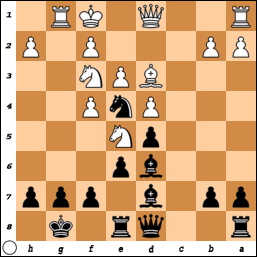TURNED out on top board last night for The Dogs Of Battersea against Shazam Druids in the 150-average division of London's Summer League.
 |
| Black has just played 36...Ke8-e7 and offered a draw in Spanton (168) - David Rowson (183) |
*****
*****
*****
*****
*****
*****
*****
*****
37.Kd2
Yes, it is a rook-and-pawn ending, and, yes, material is equal, but on putting the game into ChessBase I was surprised that my main analysis engines, Komodo9 and Stockfish10, at first rate the position as about equal. The latter soon changes to giving White a slight edge, but Komodo9 sticks with an equals sign (albeit reckoning White is almost a fifth of a pawn ahead).
37...Ke8
Interesting but double-edged is 37...Rd6!? In order to play it, Black has to be confident the pawn-ending after 38.Rxd6 cxd6 is drawn. It may be, but White is certainly a little better. And anyway White is not forced to exchange rooks; he could play 38.Rd3 instead, and prepare to activate his kingside majority with similar play to the game.
38.g4 h6 39.h4 c6 40.Rd3 Ke7 41.a4 a5 42.Re3?
This gives drawing chances. Correct was 42.Ke3, as we shall see later in the game.
42...Rd6+ 43.Rd3 Re6?
The engines give 43...g5 as drawing, the point being that 44.Rxd6 Kxd6 45.Ke3 Ke5 46.h5 is met by 46...Kd6! (46...Ke6 may also draw, but is a lot more complicated) 47.f4 gxf4+ 48.Kxf4 Ke6, when there is no way for White to make progress.
In the above line, White can try 46.f4+!? gxf4+ 47.Kf3, but it seems Black holds with 47...b5! 48.axb5 cxb5 49.cxb5 c4 (49...Kd6 50.Kxf4 c4 transposes) 50.bxc4 Kd6 51.Kxf4 a4 52.g5 fxg5+ 53.hxg5 hxg5+ 54.Kf5! a3 55.e5+ Kc7 56.e6 a2 57.b6+! Kxb6 58.e7 a1=Q 59.e8=Q Qf1+. This would have been extremely difficult, for both sides, to work out over the board, but the engines are in complete agreement on their analysis.
44.Ke3 f5!
This is the engines' choice. Black cannot try to stay pat, eg 44...Ke8? 45.Kf4 Ke7, when 46.g5 gives White a protected passed pawn.
45.gxf5?!
It seems 45.Rd2!? was better, eg 45...fxg4 46.fxg4 g5 (best, according to the engines) 47.hxg5 hxg5 48.Rh2 Kd6 (Black cannot afford a pawn-ending) 49.Rh8 Rg6, when Black is very passive, but not necessarily lost.
45...gxf5 46.Kf4 fxe4 47.fxe4 Rf6+ 48.Kg4 Re6 49.Re3 Kf6?
Black almost certainly draws with 49...Re5, eg 50.Kf4 Rh5 51.Rh3 Ke6.
50.e5!
Also probably winning, but not so quickly, is 50.Kf4, as now 50...Re5 is met by 51.Rd3 Rh5 52.Kg4 Re5 53.Kf3 Rh5 54.Kg3 Re5 (White's dancing with the king is so Black's rook will capture on e5 without giving check) 55.Rxc6 Rxe4 56.Rxb6.
50...Ke7
Or 50...Rxe5 51.Rxe5 Kxe5 52.Kh5 etc.
51.Kf5 b5 52.Rg3 1-0
If 52...Kf7, then 53.Rg7+! wins.
The Dogs Of Battersea won the match 2.5-1.5.
My updated Battersea statistics for 2018-19
Event...Colour...Grade...Opponent's Grade...Result
CLL........B..........167...….........196...............…D
LL...…….B...…...167...………..159...………….D
CLL...…..B...…...167...………..161...………….W
CLL...…..B...…...167...………..190...………….D
LL...…….W...…..167...………..161...….………W
CLL...…..W...…..167...………..148...………….D
CLL...…..W...…..167...………..165...………….W
CLL...…..W...…..167...………..160...………….D
CLL...…..W...…..167...………..159...………….D
LL...…….B...…...167...………..168...………….D
LL...…….W...…..171...………..159...………….W
CLL...…..B...…...171...………..198...……….….L
CLL...…..B...…...171...………..169...…………..L
CLL...…..B...…...171...………..196...…………..L
LL...…….B...…...171...………..182...…………..D
CLL...…..W...…..171...………..189...…………..L
LL...…….B...…...171...………..178...…………..L
CLL...…..B...…...171...………..164...…………..D
LL...…….B...…...171...………..188...………….W
CLL...…..B...…...171...………..200...…………..L
LL...…….B...…...171...………..169...…………..L
CLL...…..W...…..171...………..186...…………..D
CLL...…..B...…...171...………..153...…………..D
LL...……W...…...171...………..188...…………..L
LL...……W...…...171...………..159...…………..L
LL...……W...…...171...………..153...…………..L
CLL...…..B...…...171...…….….172...……….....D
LL............B.........171................139..................W
LL...….….B...…..171...…….….214...……....….L
LL...……..B...…..171...………..173...……….….L
LL...…….W...…..171...………..166...…………..L
SL...……..B...…..171...………..167...………….W
LL...…….W...…..171...………..122...………….W
SL...……..B...…..171...………..159...………….W
SL...…….W...…..168...………..140(est)………W
SL...…….W...…..168...………..183...………….W
Overall this season for Battersea I have scored +11=12-13 for a grading performance of 168.
In season 2017-18 I scored +10=8-9 for a grading performance of 175.
CLL - Central London League; LL - London League; SL - Summer League




















